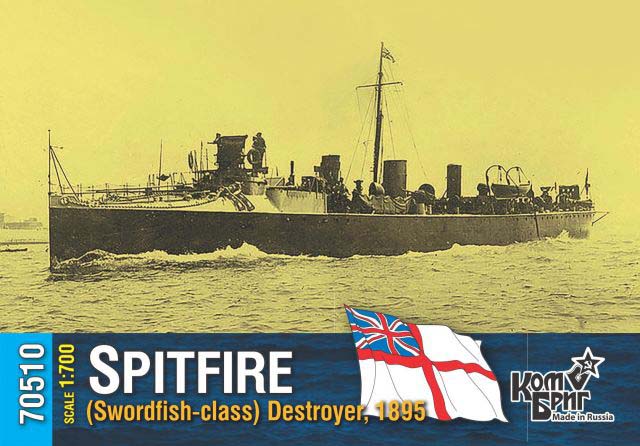1/700 HMS Spitfire 1895


|
by Martin J Quinn |
|
| HISTORY | |
| Two Swordfish-class destroyers served with
the Royal Navy. Swordfish and Spitfire were both built by
Armstrong Whitworth at Elswick, Tyne and Wear launching in 1895. Fitted
with Yarrow boilers, they could make 27 knots and were armed with one twelve
pounder and two torpedo tubes.
HMS Spitfire was launched on 7 June 1895 by Armstrong Mitchell & Co. at Newcastle upon Tyne. Spitfire served in home waters. In early February 1900 she had repairs at Chatham, before joining the Medway instructional flotilla. She was tender to Wildfire, the shore establishment at Sheerness. She underwent repairs to re-tube her boilers in 1902. On 7 May 1902 she was commissioned as tender to the cruiser Immortalité, which itself served as a sea-going tender at Sheerness. Spitfire's ultimate fate is unknown. For further information, check out the Wikipedia page (where this information came from) for her class here. The Swordfish-class were mentioned as being "unsatisfactory" and as poor sea boats with limited stability in Norman Friedman's "British Destroyers, From the Earliest Days to the Second World War". |
| The Combrig Spitfire
Spitfire is packaged in a thin, white cardboard box, with a photo of the real vessel on the box top. Inside the box is the hull in one bag, and four runners, consisting of almost 60 parts in a second bag. These are all secured with packaging peanuts. The small parts were all in a single bag, which led to some unfortunate damage. It still puzzles me why Combrig puts multiple delicate parts into a single bag. |
|||||||||||||||||
|
|||||||||||||||||
| THE HULL | |||||||||||||||||
| The hull is waterline, traditional
for 700 scale. According to the measurements I found for
Spitfire,
the hull scales out pretty close in both length and beam. The
top of the hull is very well cast with lots of good detail.
As with some of the other destroyer kits I've reviewed, there are some
faint lines on the sides of the hull, and especially on the deck.
This may be carry over from the master, if it was 3D printed.
There is a large, but thin, over pour of resin on the bottom of the hull. There is also a piece of resin over pour on the stern, similar to what I found on Cygnet. The hull of the Spitfire is not a re-pop of other Combrig early Royal Navy destroyers. It's quite different from both the Ardent and Cygnet, as seen in the photos below. |
|||||||||||||||||
|
|||||||||||||||||
| SMALLER PARTS | |||||||||||||||||
| There are five resin runners in the kit. Here are the funnels, guns, torpedo tubes, vents, boats, platforms and anchors, along with other small parts. All these smaller parts really well cast, especially the guns and torpedo tubes. The anchors are especially thin. Unfortunately, due to the co-mingling of the parts in one bag, the tops of all four davits were snapped off. | |||||||||||||||||
|
|||||||||||||||||
| PHOTOETCH | |||||||||||||||||
| There is no photo-etch included with
the kit. You will have to source your own railings.
Nor are there are any masts included with the kit. As per usual Combrig practice, there are drawings showing dimensions of the masts and yards. |
|||||||||||||||||
| INSTRUCTIONS | |||||||||||||||||
| The instructions are typical Combrig
fare, with the bare minimum included to build the model. Printed
on just one side of one piece of paper, there is a list the parts and two
exploded views showing where to place the parts. There is no plan
and profile view of Spitfire included.
There are no color callouts or painting instructions, but the box would seem to indicate she was painted overall black. Instructions are still a place that Combrig's could show some improvement. |
|||||||||||||||||
|
|||||||||||||||||
| CONCLUSIONS | |||||||||||||||||
| Yet another torpedo boat destroyer
variant from Combrig. The depth and breath of their releases
should please many fans of early destroyers. You'll certainly have
much to choose from, including this nice little kit of Spitfire.
The only issue I found with it is the over pour on the bottom of the hull
and the stern. I'd also like to see Combrig continue to improve
their packaging, and bag the smaller parts separately from each other.
Recommended.
This is Combrig’s 1/700 USS Spitfire, kit number 70510. The model lists for $19.95 and is available from many of our fine sponsors. This is an in-box review. While the model seems to compare nicely to photos found in books and online, your mileage may vary once you commence construction. Thanks to Combrig Models for the review sample. |
 |
||||||||||||||||
